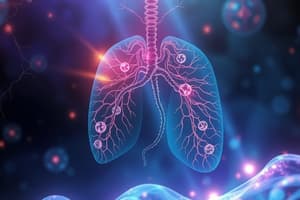Podcast
Questions and Answers
Which of the following is a product of glycolysis?
Which of the following is a product of glycolysis?
- Pyruvate (correct)
- FADH2
- NADH
- ATP
What is the main purpose of oxidative phosphorylation in cellular respiration?
What is the main purpose of oxidative phosphorylation in cellular respiration?
- To convert pyruvate to acetyl CoA
- To produce NADH and FADH2
- To produce ATP using the energy from electron transport chain (correct)
- To convert glucose to pyruvate
What is the key difference between substrate level phosphorylation and oxidative phosphorylation?
What is the key difference between substrate level phosphorylation and oxidative phosphorylation?
- Location in the cell
- Number of ATP produced
- Source of phosphate group (correct)
- Speed of reaction
What is the final electron acceptor in the electron transport chain during cellular respiration?
What is the final electron acceptor in the electron transport chain during cellular respiration?
What is the main difference between aerobic respiration and anaerobic respiration?
What is the main difference between aerobic respiration and anaerobic respiration?
What is the overall purpose of cellular respiration?
What is the overall purpose of cellular respiration?
What is the final electron acceptor in the electron transport chain (ETC)?
What is the final electron acceptor in the electron transport chain (ETC)?
What process creates a H+ gradient with increasing H+ in the intermembrane space?
What process creates a H+ gradient with increasing H+ in the intermembrane space?
What is the initial reactant necessary for the ETC to start?
What is the initial reactant necessary for the ETC to start?
Which protein ultimately produces ATP in the ETC?
Which protein ultimately produces ATP in the ETC?
What is the overall product of cellular respiration?
What is the overall product of cellular respiration?
What is the ancient and universal energy-harvesting process of life?
What is the ancient and universal energy-harvesting process of life?
What is the main function of fermentation?
What is the main function of fermentation?
What do obligate anaerobes require for energy production?
What do obligate anaerobes require for energy production?
How many ATP molecules are produced per glucose molecule in fermentation?
How many ATP molecules are produced per glucose molecule in fermentation?
What is the main purpose of cellular respiration?
What is the main purpose of cellular respiration?
What is the difference between respiration and cellular respiration?
What is the difference between respiration and cellular respiration?
Which electron carriers play a crucial role in cellular respiration?
Which electron carriers play a crucial role in cellular respiration?
Where does glycolysis occur?
Where does glycolysis occur?
What is the process of glycolysis?
What is the process of glycolysis?
What occurs in the energy investment phase of glycolysis?
What occurs in the energy investment phase of glycolysis?
What is the main product of the citric acid cycle in cellular respiration?
What is the main product of the citric acid cycle in cellular respiration?
What is the net total ATP produced from one molecule of glucose through glycolysis?
What is the net total ATP produced from one molecule of glucose through glycolysis?
Where does the citric acid cycle occur?
Where does the citric acid cycle occur?
What inhibits the enzyme phosphofructokinase in glycolysis?
What inhibits the enzyme phosphofructokinase in glycolysis?
What is the primary function of oxidative phosphorylation?
What is the primary function of oxidative phosphorylation?
What is the total of NADH molecules produced from one turn in citric acid cycle?
What is the total of NADH molecules produced from one turn in citric acid cycle?
How many NADH produced from 2 turns in citric acid cycle?
How many NADH produced from 2 turns in citric acid cycle?
Flashcards are hidden until you start studying
Study Notes
Cellular Respiration: Glycolysis, Citric Acid Cycle, and Oxidative Phosphorylation
- Glycolysis is the initial step of cellular respiration, occurring in the cytoplasm, and can happen with or without oxygen.
- Glycolysis is regulated by negative feedback inhibition of the enzyme phosphofructokinase, with high ATP levels inhibiting the enzyme.
- Pyruvate oxidation and the citric acid cycle follow glycolysis, occurring in the mitochondrial matrix, and they complete the oxidation and breakdown of glucose.
- The citric acid cycle, also known as the Krebs cycle, generates CO2 and many NADH and FADH2 molecules, essential for the electron transport chain/oxidative phosphorylation.
- The citric acid cycle is regulated by feedback inhibition, with reaction rates being high when ATP and NADH are scarce.
- One turn of the citric acid cycle generates CO2, 1 ATP, 3 NADH, and 1 FADH2, while two turns generate CO2, 2 ATP, 6 NADH, and 2 FADH2.
- Oxidative phosphorylation involves the electron transport chain and chemiosmosis, where NADH and FADH2 deliver electrons to produce ATP.
- The electron transport chain is a series of protein complexes embedded in the inner mitochondrial membrane, which moves electrons down a hill toward oxygen, ultimately producing water.
- The net total products from one starting molecule of glucose include 4 ATP from glycolysis, 10 NADH, 2 FADH2, and 2 ATP from the citric acid cycle.
- Oxidative phosphorylation involves electron transport and chemiosmosis, where high-energy electrons from NADH and FADH2 are used to produce ATP.
- The electron transport chain is a series of protein complexes in the mitochondrial membrane, moving electrons toward oxygen to produce ATP.
- Oxidative phosphorylation involves NADH and FADH2 delivering electrons to protein complexes in the mitochondrial membrane, leading to the production of ATP.
Studying That Suits You
Use AI to generate personalized quizzes and flashcards to suit your learning preferences.




